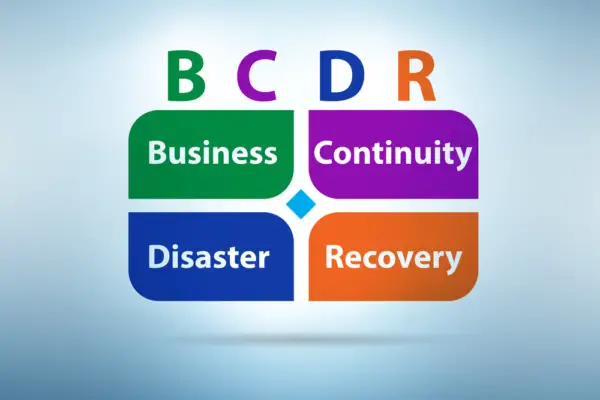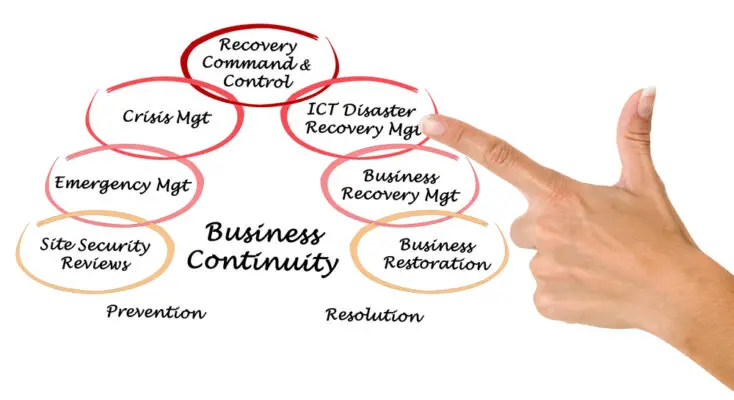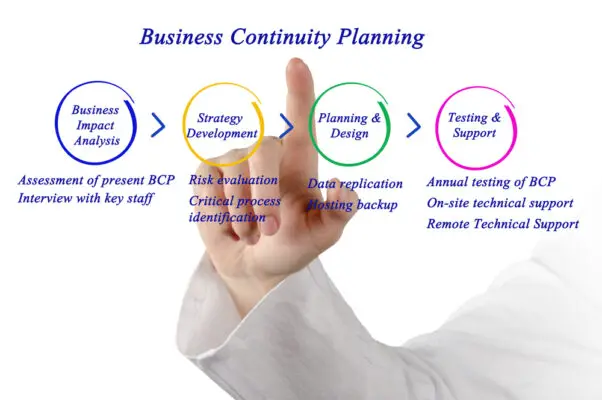A Business Continuity Plan (BCP) Risk Assessment is a critical process that involves identifying and assessing risks that could disrupt an organization’s operations. BCP assessment aims to understand the potential threats to the organization and their impacts on business operations and to inform the development of strategies to mitigate these risks.
Risk is an inevitable part of operations in today’s volatile business environment. But your organisation can better navigate potential threats by implementing comprehensive risk assessments as part of your Business Continuity Plan (BCP).
This article, titled ‘Unpacking Risk Assessment: Business Continuity Plan Risk Assessment,’ aims to provide a comprehensive overview of the importance of risk assessment in business continuity planning.
It will explore common mistakes to avoid, the risk assessment process, the significance of business impact analysis, and cybersecurity policies.
Let’s unpack the crucial role of risk assessments in business continuity planning.

Understanding Risk Assessment in Business Continuity Planning
At its core, risk assessment in a Business Continuity Plan involves identifying potential threats and evaluating their likely impact on your business operations. By analyzing these risks, your organization can devise strategies to mitigate them and ensure the continuity of critical business functions even during a disruption.
The Importance of Risk Assessment in Your BCP
A robust risk assessment is an essential cornerstone of your BCP. It allows your organization to:
- Identify potential hazards or disruptions that could adversely affect your operations.
- Evaluate the likelihood and impact of these risks.
- Prioritize risks based on their potential impact.
- Develop effective strategies to mitigate these risks.
Steps to Conducting a Risk Assessment for Your BCP
Here’s a step-by-step guide to performing a risk assessment within the framework of your Business Continuity Plan:
Step 1: Risk Identification
Start by identifying the potential risks that could disrupt your business. These could range from natural disasters and cyber-attacks to supply chain disruptions and regulatory changes.
Step 2: Risk Analysis
Next, analyze each identified risk. Determine its likelihood and the potential severity of its impact on your operations. Consider both immediate and long-term effects.
Step 3: Risk Evaluation
Evaluate the risks based on their likelihood and potential impact. This will help you prioritize the risks and focus your mitigation strategies on the most significant threats.
Step 4: Risk Mitigation
Develop strategies to manage each identified risk. These strategies could include risk avoidance, reduction, transfer, or acceptance.
Business continuity planning is a critical aspect of modern business operations. With the increasing frequency and severity of natural disasters, cyberattacks, and other unexpected events, organizations need to develop and implement robust plans to ensure that they can continue to operate in the face of disruptions.
Risk assessment is a crucial component of business continuity planning, as it helps organizations identify potential risks, evaluate their likelihood and potential impact, and develop strategies to prevent or mitigate them.
Overview
Understanding the process of evaluating potential hazards and prioritizing risks is fundamental to creating a comprehensive plan for ensuring the continuity of business operations in the face of unexpected disruptions.
Risk assessment is essential in Business Continuity Planning (BCP) as it systematically identifies potential threats and vulnerabilities that could disrupt operations.
It involves assessing an event’s likelihood and impact on the organization. Risk assessment should be carried out before undertaking a Business Impact Analysis (BIA) as it helps identify potential threats that could impact critical business functions.
The BIA then evaluates the impact of these threats on business operations, allowing organizations to prioritize their response strategies.
A comprehensive risk assessment should identify potential threats, evaluate the likelihood of those threats occurring, and determine the potential impact on the organization.
The ongoing risk assessment process should be reviewed and updated regularly to ensure it remains relevant and reflects the organization’s current risk posture.
To be effective, a risk assessment should be conducted by trained professionals who can identify threats and vulnerabilities and evaluate their potential impact on the organization.
The risk assessment findings should inform the development of a BCP, including identifying key processes and resources, developing response strategies, and creating a plan for maintaining business operations in the face of unexpected disruptions.
Common Mistakes
These mistakes include not accounting for the loss of critical people, not planning for staff stress and trauma, and not having alternative recovery sites.
These mistakes can lead to a lack of preparedness during unexpected events, which can have severe consequences for the business.
For example, not accounting for the loss of critical people can result in a lack of expertise and knowledge, which can be detrimental to the smooth functioning of the organization.
Another common mistake in business continuity planning is not making emergency plans accessible. Emergency plans should be accessible to all employees, including remotely.
This can help ensure everyone is on the same page and knows what to do when an unexpected event occurs.
Not communicating plans and processes transparently is also a mistake. Communication is essential during a crisis; transparent communication can help build employee trust and confidence.
Not having alternative recovery sites is another mistake that can have severe consequences. If the primary recovery site is unavailable, the organization should have an alternative site ready to ensure continuity of business operations.
Failure to plan for alternative recovery sites can lead to prolonged downtime, which can be costly for the business.
Overall, it is essential to avoid these common mistakes to ensure that the business is prepared to navigate unexpected events and maintain continuity of operations.
Risk Assessment Process
The process involves identifying and describing risks, prioritizing risks associated with essential recovery processes, and evaluating risks to compare results with the organization’s risk tolerance.
It is important to venture outside the scope of risk assessment to find information that supports evaluation and have workshops with the enterprise risk team to test the articulation of risks.
The risk assessment process should focus on risks that have the potential to disrupt the business recovery process during a disaster. Risks associated with processes essential to the organization’s recovery process should be identified, and unforeseeable risks should not be anticipated.
The identified risks should be closely related to overall business continuity, and mitigation controls should justify the investment to mitigate.
The findings from the risk assessment process will be valuable input in designing a business recovery strategy, which will be the next step in the program.
The risk assessment process is integral to business continuity planning. It helps organizations prepare for and mitigate risks, prevent injuries or illnesses, meet legal requirements, create awareness about hazards and risks, create an accurate inventory of available assets, justify the cost of managing risks, determine the budget to remediate risks and understand the return on investment.
A specialized compliance specialist can help with the risk assessment process, and risk assessment plans should be reviewed and updated regularly to stay on top of new hazards.
Business Impact Analysis
A thorough Business Impact Analysis is critical for organizations to gauge the impact of specific risks on their business operations and financial implications, ultimately leading to a more effective and resilient Business Continuity Plan.
The analysis involves identifying and assessing the potential consequences of disruptive events on critical business functions, assets, and stakeholders.
It considers the time required for recovery, the cost of recovery, and the impact on revenue, reputation, and customer satisfaction.
The Business Impact Analysis enables organizations to prioritize recovery efforts and allocate resources effectively. It also helps them identify areas for improvement in their Business Continuity Plan.
By understanding the potential impact of risks, organizations can develop strategies to mitigate or minimize the severity of the consequences. They can also identify opportunities to enhance their resilience and overall performance.
Business Impact Analysis is an essential step in the risk assessment process for Business Continuity Planning. It helps organizations understand the potential impact of disruptive events on their operations, finances, and reputation.
Conducting a thorough analysis, organizations can prioritize their recovery efforts, allocate resources effectively, and develop strategies to mitigate or minimize the consequences of risks. This will ultimately lead to a more effective and resilient Business Continuity Plan.
Reporting and Review
Reporting and Review is a crucial step in the Business Impact Analysis process as it allows organizations to present their findings to stakeholders and obtain feedback. This feedback is important as it helps organizations to improve their Business Continuity Plan.
Reporting and Review also enable organizations to identify any gaps in their plan and make the necessary changes to better prepare for the risks identified during the risk assessment.
During the Reporting and Review process, it is important to use templates familiar to the enterprise risk team to report findings. These templates help to ensure consistency in reporting and make it easier for stakeholders to understand the findings.
It is also important to provide a high-level update to the steering committee and review the report with the GRC or enterprise risk management team. This review process helps to ensure that the findings are accurate and that the Business Continuity Plan is aligned with the enterprise risk management practices.
Reporting and Review is an essential step in the Business Impact Analysis process. The feedback obtained during this process is crucial in improving the Business Continuity Plan and ensuring that the organization is better prepared for the risks identified during the risk assessment process.

Frequently Asked Questions
1. What is a Risk Assessment in a Business Continuity Plan?
A Risk Assessment in a Business Continuity Plan is a process that involves identifying and assessing potential risks that could disrupt an organization’s operations. The goal is to understand the potential threats to the business and their impact and to develop strategies to mitigate these risks.
2. What steps are involved in conducting a Risk Assessment for a Business Continuity Plan?
The steps for conducting a risk assessment include the following:
- Risk Identification: Identifying the potential risks that could disrupt business operations.
- Risk Analysis: Determining the likelihood and potential impact of these risks.
- Risk Evaluation: Evaluating and prioritizing the risks based on their potential impact.
- Risk Treatment: Develop strategies to manage or mitigate each risk.
3. Why is a Risk Assessment important for a Business Continuity Plan?
Risk assessment is crucial for a Business Continuity Plan as it helps organizations identify potential threats, understand their possible impact, and devise strategies to mitigate them. It contributes to building a resilient organization that can respond effectively to disruptions, ensuring the continuity of critical business functions.
4. How often should Risk Assessments be conducted?
Risk assessments should be an ongoing process, and the frequency of formal reviews will depend on the nature and context of the organization. However, it’s generally recommended that risk assessments be conducted at least annually or when there are significant changes to the organization or its environment.
5. What is the role of Risk Treatment in a Business Continuity Plan?
Risk treatment involves deciding on and implementing strategies to manage or mitigate each identified risk. This could include preventive measures, contingency plans for response and recovery, transferring the risk (for instance, through insurance), or accepting the risk if it’s within the organization’s risk tolerance.
6. Can a Business Continuity Plan eliminate all risks?
While a Business Continuity Plan aims to mitigate potential threats and disruptions, it can’t eliminate all risks. The unpredictable nature of many risks, like natural disasters or cyberattacks, means there will always be some level of risk. However, a robust Business Continuity Plan can significantly reduce the impact of disruptions and enable quicker recovery.

Conclusion
Risk assessment is a crucial component of business continuity planning that involves identifying and analyzing potential risks to an organization’s operations. It allows businesses to evaluate the likelihood and potential impact of various risks and develop strategies to prevent or mitigate them.
To ensure the success of a risk assessment process, organizations must avoid common mistakes, such as failing to involve key stakeholders or neglecting to update the assessment regularly.
Business impact analysis is also a critical aspect of risk assessment that helps organizations understand the potential consequences of a disruption and prioritize recovery efforts accordingly.
Additionally, cybersecurity policies must be integrated into the risk assessment process to address the increasing cyber-attack threat.
By following best practices for conducting risk assessments, organizations can enhance their ability to maintain business continuity in the face of unexpected disruptions and ensure the long-term success of their operations.

Chris Ekai is a Risk Management expert with over 10 years of experience in the field. He has a Master’s(MSc) degree in Risk Management from University of Portsmouth and is a CPA and Finance professional. He currently works as a Content Manager at Risk Publishing, writing about Enterprise Risk Management, Business Continuity Management and Project Management.

